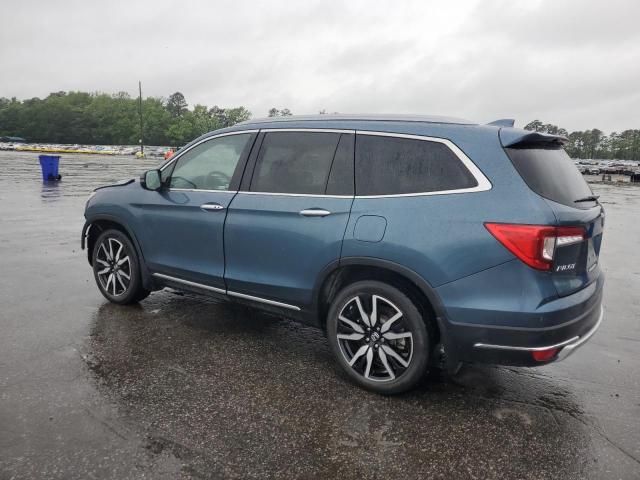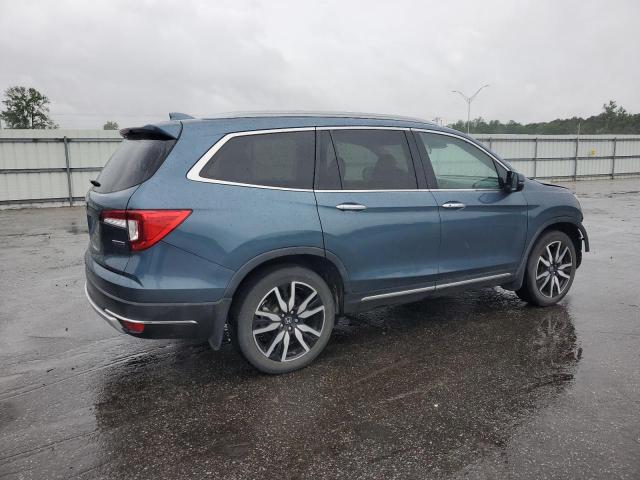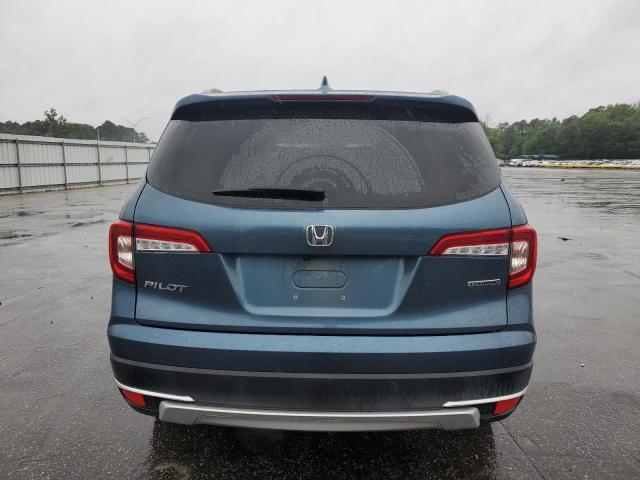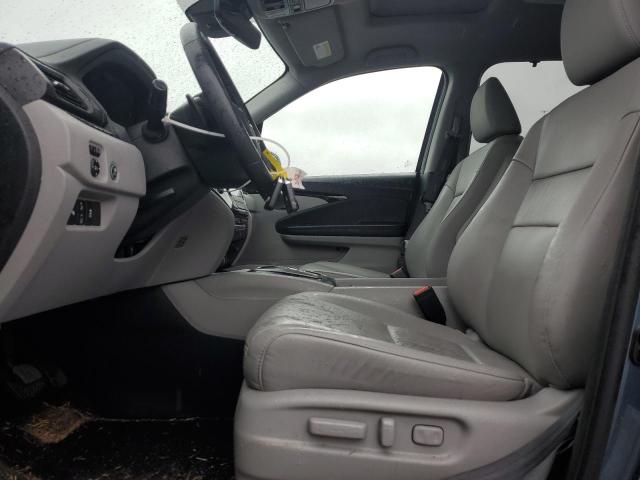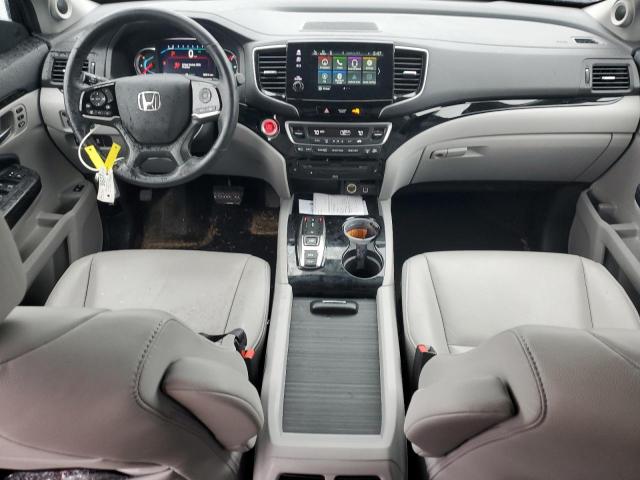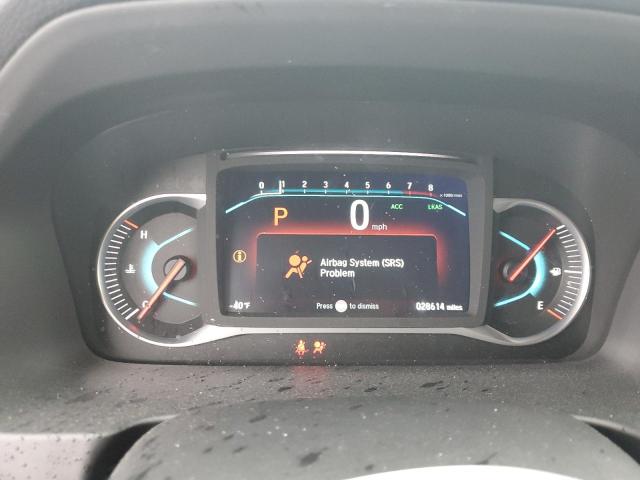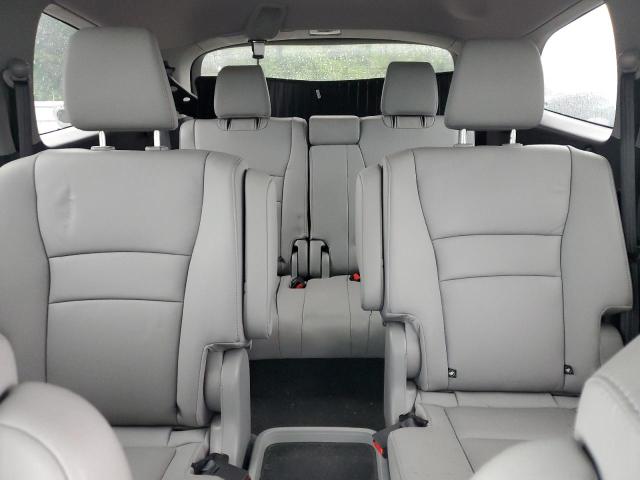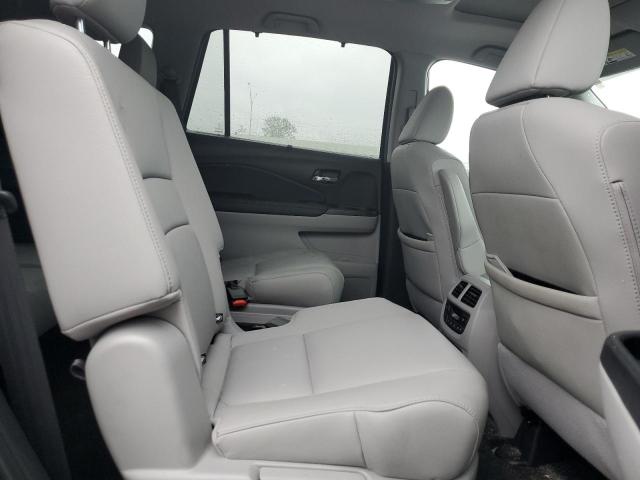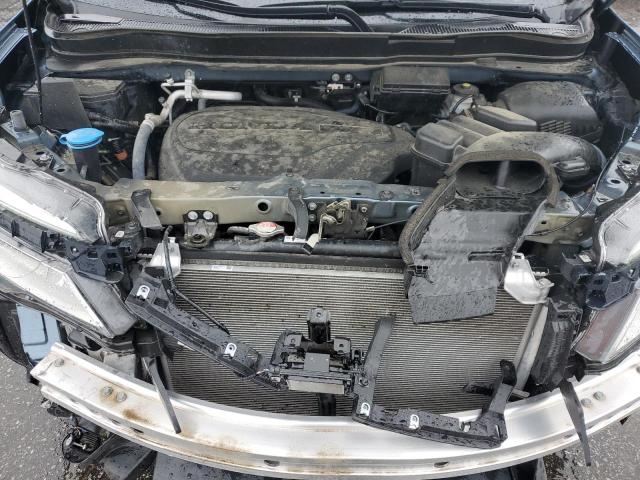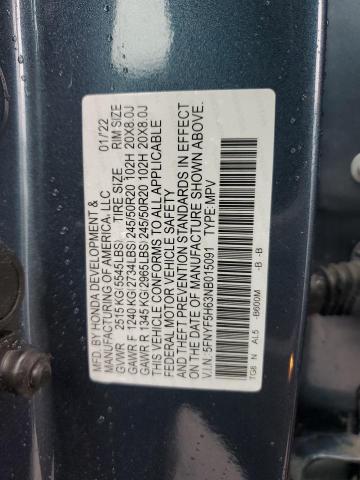2022 HONDA PILOT | 5FNYF5H63NB015091
 ❯
❯
Specifications
1
~$40,000
Engine: 3.5L naturally aspirated V6
Torque: 355 Nm
0–100 km/h: ~6.7 s
While not a performance SUV, the Honda Pilot delivers surprisingly strong acceleration for a three-row midsize crossover. Its 3.5L V6 engine produces 280 horsepower and 355 Nm of torque, allowing it to sprint from 0 to 100 km/h in about 6.7 seconds—quick for a family-focused SUV. Paired with a smooth 9-speed (later 10-speed in 2021+) automatic transmission, the Pilot offers seamless power delivery and refined responsiveness, whether cruising on the highway or merging into fast traffic.
The Pilot handles predictably and comfortably, with well-calibrated electric power steering and a suspension tuned for ride quality rather than sharpness. Nevertheless, its unibody construction and relatively low center of gravity allow for composed cornering and minimal body roll compared to body-on-frame competitors. The available i-VTM4 torque-vectoring all-wheel-drive system improves grip on slippery roads and light trails, subtly enhancing stability during dynamic maneuvers.
Though it's not built to rival sport utility crossovers like the Mazda CX-9 or Dodge Durango R/T, the Pilot offers a smooth and confidence-inspiring drive. It blends strong V6 power, intelligent AWD, and family-oriented usability into a package that feels lively enough to satisfy drivers looking for more than just minivan functionality.
Body Styles
The Honda Pilot is a three-row midsize crossover SUV with a traditional upright SUV profile, gently sculpted body panels, and soft aerodynamic curves. Its shape emphasizes interior space, with a long wheelbase, wide stance, and high roofline that optimize headroom and third-row access. The front fascia features a broad grille, sleek LED headlights, and a sculpted hood that evolved subtly through facelifts (notably in 2019). A modest rear spoiler, wraparound taillights, and integrated roof rails reinforce its utility, while 20-inch wheels on higher trims add a touch of luxury. Despite its conservative look, the Pilot maintains a clean and cohesive design, prioritizing practicality with just the right amount of presence.
Model Name Meaning (Manufacturer)
The name “Pilot” was selected by Honda to emphasize leadership, direction, and adventure—characteristics meant to resonate with families and individuals seeking a reliable, go-anywhere, do-anything vehicle. It suggests control and versatility, much like the vehicle itself, which is designed to “pilot” its passengers through daily life, long trips, and occasional off-road excursions with confidence and ease.
Model Name Meaning (Languages)
“Pilot” is a universally recognized English word that denotes someone who navigates or leads—whether an aircraft, ship, or mission. It evokes images of guidance, exploration, and reliability. Its simplicity, international familiarity, and positive connotations make it an ideal nameplate for a global SUV. The term is easy to pronounce across most languages and aligns well with the vehicle’s role as a steady and capable family leader.
Body & Interior Colors and Rims
The Honda Pilot was offered in a refined range of exterior colors across its trims, including Obsidian Blue Pearl, Crystal Black Pearl, Lunar Silver Metallic, Modern Steel Metallic, Deep Scarlet Pearl, and Platinum White Pearl. Higher trims introduced Black Edition and Elite-specific colors with gloss-black grille finishes, darkened wheels, and exclusive badging. Subtle chrome accents, LED fog lights, and integrated roof rails further distinguished upper trims, while Sport and EX trims leaned toward a clean, functional aesthetic.
Inside, the Pilot featured practical and upscale design across its three rows. Lower trims used durable cloth upholstery in gray or beige, while EX-L and above introduced soft leather seating, woodgrain or brushed-aluminum accents, and ambient lighting. Elite and Black Edition trims offered perforated leather with contrasting piping, panoramic roofs, ventilated front seats, and second-row captain’s chairs. The dashboard layout was horizontal and intuitive, with a digital instrument cluster, physical HVAC controls, and available 8-inch touchscreen infotainment with Apple CarPlay and Android Auto.
Wheel designs varied from 18-inch machine-finish alloys on EX and EX-L to exclusive 20-inch gloss-black or two-tone alloys on Touring, Elite, and Black Edition trims. The larger wheels fill the arches more completely, giving the Pilot a broader stance without compromising ride comfort. The simple yet bold five- and ten-spoke designs reflect the vehicle’s mix of rugged capability and urban sophistication.
Top Expensive Options
- Honda Sensing Advanced Safety Suite (Standard on EX+): $0–$1,000
- Rear Entertainment System with Blu-ray Player: $1,500
- Panoramic Roof with Power Sunshade (Elite/Black Edition): $1,200
- Second-Row Captain’s Chairs: $300
- 10-Speed Automatic Transmission (Touring+ 2021–): Standard
- Integrated Navigation with HD Traffic: $1,000
- Wireless Phone Charger (Elite+): $350
- Heated and Ventilated Front Seats: $750
- Hands-Free Power Tailgate: $600
- LED Headlights and Fog Lights: Standard or $800 (depending on trim)
vs Competitors
The Honda Pilot competes directly with the Toyota Highlander, Ford Explorer, Chevrolet Traverse, Hyundai Palisade, and Kia Telluride. Among them, the Pilot stands out for its strong V6 powertrain, well-sorted chassis, and Honda’s reputation for long-term reliability. It offers better third-row access than the Highlander, more user-friendly tech than the Explorer (pre-2022), and greater cargo versatility than the Palisade. Against the Telluride and Palisade—its toughest modern rivals—the Pilot trades some interior flair for proven engineering and a spacious, straightforward layout. Its AWD system, ground clearance, and 5,000-lb towing capacity also give it a slight advantage for active families seeking real utility. Though aging by 2022, the Pilot remained a strong value proposition with impressive space, comfort, and all-weather confidence.
Fun Fact
The Pilot was the first Honda SUV designed primarily in the U.S. and built in Alabama, with North American families specifically in mind. Uniquely, it was one of the few three-row crossovers during its time to include a hidden underfloor storage bin beneath the cargo area—even with all rows up—making it a favorite among road-tripping parents and outdoor adventurers alike.
Lot Details
-
Sale Date12/Jun/2025
-
Lot Number56323725
-
Location
-
Odometer28,614 miles (46,050 km)
-
Primary Damage:FRONT END
-
Secondary DamageSIDE
-
Fuel
-
Engine Type3.5L 6
-
Transmission
-
Drive Type
-
Color
Final Bid Honda Pilot (2022)
$10,000
$12,881
$25,750
Specifications
1
~$40,000
Torque:
0–100 km/h:
While not a performance SUV, the Honda Pilot delivers surprisingly strong acceleration for a three-row midsize crossover. Its 3.5L V6 engine produces 280 horsepower and 355 Nm of torque, allowing it to sprint from 0 to 100 km/h in about 6.7 seconds—quick for a family-focused SUV. Paired with a smooth 9-speed (later 10-speed in 2021+) automatic transmission, the Pilot offers seamless power delivery and refined responsiveness, whether cruising on the highway or merging into fast traffic.
The Pilot handles predictably and comfortably, with well-calibrated electric power steering and a suspension tuned for ride quality rather than sharpness. Nevertheless, its unibody construction and relatively low center of gravity allow for composed cornering and minimal body roll compared to body-on-frame competitors. The available i-VTM4 torque-vectoring all-wheel-drive system improves grip on slippery roads and light trails, subtly enhancing stability during dynamic maneuvers.
Though it's not built to rival sport utility crossovers like the Mazda CX-9 or Dodge Durango R/T, the Pilot offers a smooth and confidence-inspiring drive. It blends strong V6 power, intelligent AWD, and family-oriented usability into a package that feels lively enough to satisfy drivers looking for more than just minivan functionality.
Body Styles
The Honda Pilot is a three-row midsize crossover SUV with a traditional upright SUV profile, gently sculpted body panels, and soft aerodynamic curves. Its shape emphasizes interior space, with a long wheelbase, wide stance, and high roofline that optimize headroom and third-row access. The front fascia features a broad grille, sleek LED headlights, and a sculpted hood that evolved subtly through facelifts (notably in 2019). A modest rear spoiler, wraparound taillights, and integrated roof rails reinforce its utility, while 20-inch wheels on higher trims add a touch of luxury. Despite its conservative look, the Pilot maintains a clean and cohesive design, prioritizing practicality with just the right amount of presence.
Model Name Meaning (Manufacturer)
The name “Pilot” was selected by Honda to emphasize leadership, direction, and adventure—characteristics meant to resonate with families and individuals seeking a reliable, go-anywhere, do-anything vehicle. It suggests control and versatility, much like the vehicle itself, which is designed to “pilot” its passengers through daily life, long trips, and occasional off-road excursions with confidence and ease.
Model Name Meaning (Languages)
“Pilot” is a universally recognized English word that denotes someone who navigates or leads—whether an aircraft, ship, or mission. It evokes images of guidance, exploration, and reliability. Its simplicity, international familiarity, and positive connotations make it an ideal nameplate for a global SUV. The term is easy to pronounce across most languages and aligns well with the vehicle’s role as a steady and capable family leader.
Body & Interior Colors and Rims
The Honda Pilot was offered in a refined range of exterior colors across its trims, including Obsidian Blue Pearl, Crystal Black Pearl, Lunar Silver Metallic, Modern Steel Metallic, Deep Scarlet Pearl, and Platinum White Pearl. Higher trims introduced Black Edition and Elite-specific colors with gloss-black grille finishes, darkened wheels, and exclusive badging. Subtle chrome accents, LED fog lights, and integrated roof rails further distinguished upper trims, while Sport and EX trims leaned toward a clean, functional aesthetic.
Inside, the Pilot featured practical and upscale design across its three rows. Lower trims used durable cloth upholstery in gray or beige, while EX-L and above introduced soft leather seating, woodgrain or brushed-aluminum accents, and ambient lighting. Elite and Black Edition trims offered perforated leather with contrasting piping, panoramic roofs, ventilated front seats, and second-row captain’s chairs. The dashboard layout was horizontal and intuitive, with a digital instrument cluster, physical HVAC controls, and available 8-inch touchscreen infotainment with Apple CarPlay and Android Auto.
Wheel designs varied from 18-inch machine-finish alloys on EX and EX-L to exclusive 20-inch gloss-black or two-tone alloys on Touring, Elite, and Black Edition trims. The larger wheels fill the arches more completely, giving the Pilot a broader stance without compromising ride comfort. The simple yet bold five- and ten-spoke designs reflect the vehicle’s mix of rugged capability and urban sophistication.
Top Expensive Options
- Honda Sensing Advanced Safety Suite (Standard on EX+): $0–$1,000
- Rear Entertainment System with Blu-ray Player: $1,500
- Panoramic Roof with Power Sunshade (Elite/Black Edition): $1,200
- Second-Row Captain’s Chairs: $300
- 10-Speed Automatic Transmission (Touring+ 2021–): Standard
- Integrated Navigation with HD Traffic: $1,000
- Wireless Phone Charger (Elite+): $350
- Heated and Ventilated Front Seats: $750
- Hands-Free Power Tailgate: $600
- LED Headlights and Fog Lights: Standard or $800 (depending on trim)
vs Competitors
The Honda Pilot competes directly with the Toyota Highlander, Ford Explorer, Chevrolet Traverse, Hyundai Palisade, and Kia Telluride. Among them, the Pilot stands out for its strong V6 powertrain, well-sorted chassis, and Honda’s reputation for long-term reliability. It offers better third-row access than the Highlander, more user-friendly tech than the Explorer (pre-2022), and greater cargo versatility than the Palisade. Against the Telluride and Palisade—its toughest modern rivals—the Pilot trades some interior flair for proven engineering and a spacious, straightforward layout. Its AWD system, ground clearance, and 5,000-lb towing capacity also give it a slight advantage for active families seeking real utility. Though aging by 2022, the Pilot remained a strong value proposition with impressive space, comfort, and all-weather confidence.
Fun Fact
The Pilot was the first Honda SUV designed primarily in the U.S. and built in Alabama, with North American families specifically in mind. Uniquely, it was one of the few three-row crossovers during its time to include a hidden underfloor storage bin beneath the cargo area—even with all rows up—making it a favorite among road-tripping parents and outdoor adventurers alike.

